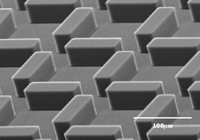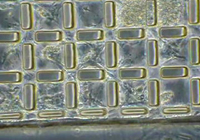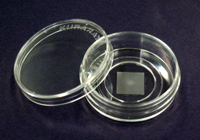Development of a Microspace Cell-culture Chip
 Microspace cell-culture chip
Microspace cell-culture chip
 Cultured cardiac muscle cells from rats
Cultured cardiac muscle cells from rats
 Disposal dish
Disposal dish
Kuraray (Headquarters: Chiyoda-ku, Tokyo; President: Yasuaki Wakui) has announced the development of basic technology for a microspace cell -culture chip. Fusing its technological expertise in the areas of polymeric materials, microprocessing, and biotechnology, Kuraray has produced a resin substrate that makes it possible to recreate the environmental conditions inside a living organism on the surface of the chip, and to stereoscopically regulate cell growth and differentiation, and direction and orientation, all of which are difficult to accomplish using existing plate culture technology.
This resin cell-culture chip has a minute three-dimensional microstructure (from a few micrometers to a few hundred micrometers) arrayed on its surface , and this microstructure regulates the three-dimensional growth and differentiation of cells seeded over the surface of the chip.
The shape and size of the three-dimensional microstructure can be customized for various types of cell and research applications, and this is expected to lead to significant breakthroughs in the fields of regenerative medicine and bioassay techniques. Specifically, it will contribute to the research into cell structure and evaluation of cell activation, for instance as a substitute for animal testing, in the development of pharmaceuticals, and research into tissue regeneration. To promote the use of this technology in more areas of research, Kuraray is developing cell-culture systems in addition to microchips.
Kuraray developed the basic technology for this chip jointly with the National Food Research Institute (Location: Tsukuba City, Ibaraki Prefecture; President: Toru Kodama), and several patents have been applied for, including some for applications. In addition, samples have been provided to a Ministry of Agriculture, Forestry and Fisheries nanotechnology-related research project being conducted by the National Food Research Institute and Hokkaido University.
The effectiveness of this chip has been demonstrated by the success of various research in which it has been used, including:
- 1. The fibroblastic cell cultivation work of Professor Michio Yazawa, Assistant Professor Masayuki Takahashi, et al of the Hokkaido University Faculty of Science.
- 2. The cultivation of bone marrow-derived cells by Professor Kenichiro Shibata, Assistant Professor Motoaki Yasuda, Adjunct Professor Yuko Kikuchi, et al of the Hokkaido University Graduate School of Dental Medicine.
- 3. The cultivation of reversibly-immortalized myocardial cells derived from rat cells by Professor Toru Oe and Adjunct Professor Kazufumi Nakamura of the Okayama University Graduate School of Medicine,Dentistry and Pharmaceutical Sciences, Department of Cardiovascular Internal Medicine, and Professor Fumihiko Kajitani et al of the same school's Department of Cardiovascular Physiology.
- 4. Basic research in marker technology for nonluminescent cells using nanopowders by President Makoto Kikuchi and Adjunct Medical Electronics Professor Yuji Morimoto of the National Defense Medical College Research Institute.
In July 2005, Kuraray will commence test marketing to medical research institutions of polystyrene disposable dishes (35mm or 60mm diameter) with microspace cell culture chips molded into the bottom. The thickness of the chips will be approximately 0.13mm to 0.15mm. They are made from transparent optical-use resin film, and are suitable for observation of cells using phase contrast microscopes, polarizing microscopes, confocal microscopes, and fluorescent imaging. Surface treatment is possible with either inorganic or organic membranes.
Kuraray will continue to apply polymeric materials technology and microprocessing technology in the development of microchips, and will expand its businesses in the domain of Life Sciences.
